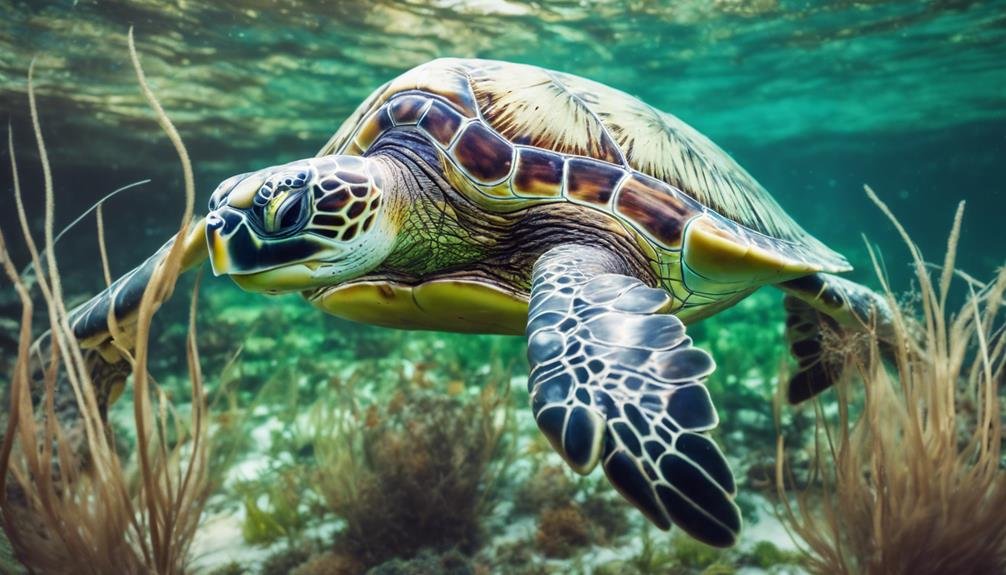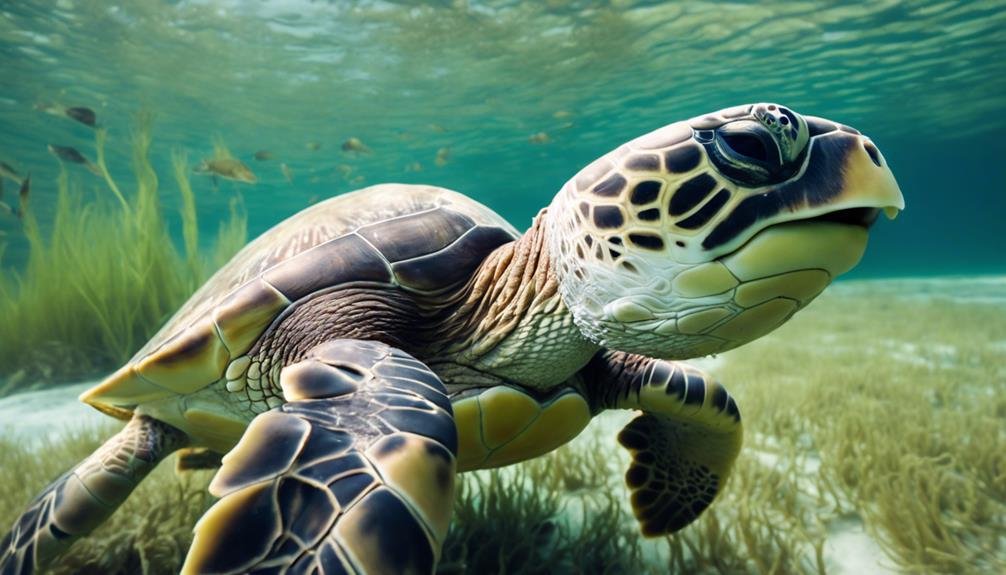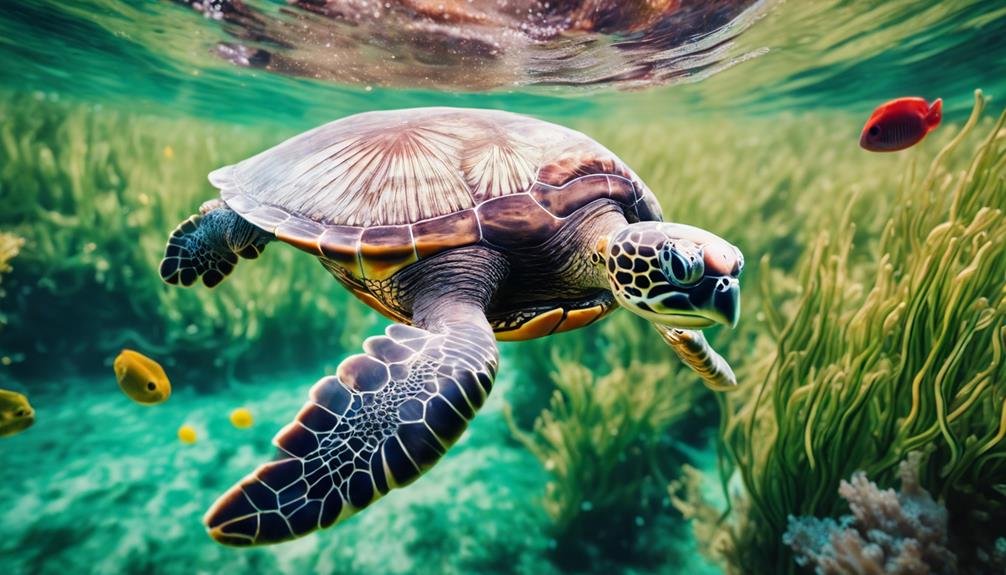You’ve likely seen images of green sea turtles gracefully swimming through crystal-clear waters, but have you ever wondered what’s on their dinner plate? These marine creatures sustain themselves primarily on seagrasses and algae, a diet that evolves from omnivorous tendencies in youth to strict herbivores in adulthood. This shift in diet plays a pivotal role not only in their survival but also in the health of the marine ecosystem. They’re equipped with specialized jaws that allow them to consume their plant-based diet efficiently, but there’s more to their feeding habits than meets the eye. Uncover their dietary preferences’ intricacies and their impact on their environment.
Key Takeaways
- Green sea turtles primarily feed on seagrasses, algae, and seaweed.
- Juvenile green sea turtles have an omnivorous diet, including jellyfish and sponges.
- Adults predominantly consume vegetation like turtle grass, manatee grass, sea lettuce, green algae, and red algae.
- Their jaws are adapted to consume a herbivorous diet as they mature efficiently.
- Occasionally, green sea turtles may ingest small amounts of animal matter.
Green Turtle Diet Basics
Understanding the basics of the green sea turtle’s diet is essential, as they’re primarily herbivores, feasting on seagrasses, algae, and seaweed. These components form the cornerstone of their nutritional intake, ensuring they have the energy needed for their daily activities and long migrations. As you dive deeper into the dietary preferences of green sea turtles, you’ll find that their commitment to a plant-based menu plays a critical role in keeping their habitats healthy and balanced.
Green sea turtles’ consumption of seagrasses and algae isn’t just about filling their stomachs. It’s an important activity that maintains coral reefs and marine ecosystems. Feeding on these plants helps prevent algae overgrowth that can suffocate corals and disrupt the delicate balance of aquatic life. This natural behavior underscores the importance of green sea turtles beyond their majestic presence in the ocean.
Their role in controlling algae populations can’t be overstated. Algae could overtake the habitats without grazing, leading to declining biodiversity and the ecosystem’s health. So, when you think about what green sea turtles eat, remember it’s not just their diet—it’s a fundamental part of their contribution to the ocean’s well-being.
Juvenile Vs. Adult Feeding Habits
The dietary habits of green sea turtles undergo a notable change as they shift from omnivorous juveniles, feasting on mollusks and crustaceans, to herbivorous adults that primarily consume algae, seagrasses, and seaweed. When looking at these majestic creatures, it’s fascinating to see how their feeding habits evolve. As juveniles, they’re not picky eaters, munching on plant and animal matter. This diverse diet is important for their growth, providing a balanced intake of nutrients.
However, as they mature, their diet narrows significantly. Adults become strict herbivores with a strong preference for certain types of marine vegetation. In the Caribbean, turtle grass becomes their meal of choice. This shift plays a crucial role in the ecosystem, particularly in maintaining the health of coral reefs. By feeding on algae, adult green sea turtles help control algae growth, which, if left unchecked, can suffocate coral reefs.
Understanding this shift from omnivorous juveniles to herbivorous adults is key in conservation efforts. It highlights the importance of protecting their diverse habitats, ensuring that green sea turtles have access to the varied diet they need as juveniles and the specific vegetation they depend on as adults.
Preferred Seagrasses and Algae


Among the variety of seagrasses and algae green sea turtles prefer, turtle grass and manatee grass stand out as favorites. These seagrasses provide essential nutrients and fiber for their health and form the cornerstone of their herbivorous diet, sustaining them throughout their lives in coastal ecosystems.
| Sea Grass | Algae | Benefit |
|---|---|---|
| Turtle Grass | Sea Lettuce | High in Nutrients |
| Manatee Grass | Green Algae | Essential Fiber |
| N/A | Red Algae | Vitamins & Minerals |
You’ll find that algae, including varieties like sea lettuce, green algae, and red algae, also play a significant role in the diet of green sea turtles. These algae offer crucial vitamins and minerals, rounding out the turtles’ nutritional needs. Consumption of these sea grasses and algae benefits the turtles and helps maintain the health and balance of coastal ecosystems. By ensuring the growth of these plants is kept in check, green sea turtles contribute to the biodiversity and stability of their habitats, showcasing the interconnectedness of life within these vibrant ecosystems.
Occasional Foods and Predation
- Beyond their usual diet, green sea turtles sometimes snack on jellyfish and sponges.
- You’ll also find that their eggs and even adults aren’t safe from predators like crabs, birds, and sharks.
- Human activities and marine debris pose significant risks, often leading to fatal outcomes.
Uncommon Dietary Choices
Surprisingly, green sea turtles occasionally spice up their mostly vegetarian diet with jellyfish, sponges, and other marine creatures. Despite their reputation as herbivores, these turtles use the sea’s bounty to add variety. This satisfies their nutritional needs and contributes to the balance of marine ecosystems.
Including these uncommon items in their diet adds important dietary diversity:
- Jellyfish – Helps regulate jellyfish populations.
- Sponges – Provides different nutrients not found in their usual plant-based diet.
- Small crustaceans, mollusks, and invertebrates – Offers protein and other essential nutrients that are scarce in seagrasses and algae.
This flexibility in their diet reflects the green sea turtles’ adaptability and their role in maintaining the health of marine environments.
Predators of Green Turtles
While green sea turtles mostly stick to a vegetarian menu, they’re not just at risk from their occasional carnivorous snacks; sharks, crocodiles, and large predatory fish pose significant threats as predators. But it’s not just the ocean’s inhabitants they’ve got to watch out for. Human activities, including poaching and habitat destruction, face formidable challenges. Even nesting females aren’t safe, as they’re vulnerable to predators like raccoons, dogs, and birds while laying eggs on the beach.
| Threats to Green Sea Turtles | Examples |
|---|---|
| Natural Predators | Sharks, Crocodiles, Large Predatory Fish |
| Human Activities | Poaching, Habitat Destruction |
| Vulnerable Times | Nesting Females |
Conservation efforts are essential, focusing on reducing human impacts and protecting nesting sites to safeguard these majestic creatures.
Jaw Adaptations for Feeding


Green sea turtles’ saw-like beaks, finely serrated for tearing seagrasses and scraping algae, showcase their adaptation to a primarily herbivorous diet. These finely serrated jaws allow them to consume their preferred vegetation efficiently and occasionally indulge in carnivorous delights like jellyfish and sponges. This versatility in diet highlights the complex nature of sea turtles’ feeding habits, evolving from carnivorous to herbivorous as they mature.
Understanding green sea turtles’ feeding mechanisms is vital to appreciating their role in the marine ecosystem. Consider these critical points:
- Specialized Jaw Structure: Their jaws are perfectly adapted to their diet, ensuring they can manage plant- and occasional animal-based food sources.
- Dietary Shift with Age: As they grow, green sea turtles shift from carnivorous feeding habits to a more herbivorous diet, showing a fascinating aspect of their development.
- Ecosystem Role: Their feeding habits contribute significantly to maintaining a balanced marine ecosystem, highlighting the interconnectedness of species and their environments.
Green sea turtles, with their finely serrated jaws, not only exemplify the marvels of evolutionary adaptation to a herbivorous diet but also underscore the importance of each species in preserving the health and balance of our marine ecosystems.
Impact on Ecosystem Health
Understanding green sea turtles’ feeding habits offers insight into their significant role in preserving marine ecosystem health. By focusing on what green sea turtles eat, you’ll see their diet consists primarily of algae and seagrasses, essential for maintaining balanced, healthy ecosystems. These green giants play a pivotal role in controlling algae growth, an important function in preventing overgrowth that can suffocate coral reefs. This balance is critical, as coral reefs are biodiversity hotspots essential for local marine life.
Moreover, green sea turtles’ preference for seagrasses isn’t just about their dietary needs; it’s also about ecosystem health. Their feeding promotes regular plant growth, which is key for coastal area vitality. This supports diverse marine species, including fish and invertebrates, and ensures these habitats remain resilient against environmental changes.
Additionally, green sea turtles contribute to nutrient cycling within these marine environments by consuming vast amounts of plant material. This process is fundamental for the ecosystem’s ability to regenerate and sustain itself. Essentially, the diet of green sea turtles underpins the health and balance of the marine ecosystems they inhabit, showcasing their indispensable role in the ocean’s ecological fabric.
Conclusion
In summary, you’ve learned that green sea turtles’ diets evolve from omnivorous as juveniles to herbivorous as adults, feasting mainly on seagrasses and algae. Their specialized jaws let them efficiently munch on their preferred greens, occasionally indulging in jellyfish and sponges.
By sticking to this diet, they’re not just feeding themselves; they’re crucial for maintaining healthy marine ecosystems, controlling algae growth, and supporting biodiversity. So, their eating habits do much more than fill their bellies; they keep the ocean thriving.
FAQs
1. Are the Dietary Habits of Green Sea Turtles Different from Other Ocean Turtles?
The dietary habits of green sea turtles compared to other ocean turtles are unique. While the turtles’ ocean diet truths vary, green sea turtles are known for their herbivorous diet, primarily consuming seagrasses and algae. Other ocean turtles may have a more varied diet, including jellyfish and small fish.
2. What Are 5 Things Sea Turtles Eat?
You’re curious about the diet of sea turtles, aren’t you? Well, they chow down on a variety of foods. As youngsters, they feast on jellyfish, snails, crabs, and shrimp. But as they grow, their tastes change.
Adult green sea turtles mainly munch on plants, like algae, seagrasses, and seaweed. They’re not just picky eaters; by eating algae, they play an important role in keeping coral reefs healthy.
3. Do Green Sea Turtles Eat Jellyfish?
You might wonder if green sea turtles munch on jellyfish. While they’re not turning their noses up at them completely, jellyfish aren’t their go-to snack.
Instead, they prefer a salad bar under the sea, feasting mostly on sea grasses, algae, and seaweed.
Sure, jellyfish might occasionally enter their diet, but it’s more of an accidental snack than a dietary staple. They’re truly the vegetarians of the turtle world.
4. Do Green Sea Turtles Drink?
You might wonder if green sea turtles need to drink water like you do. Well, they don’t. Instead, they get all the water they need from their diet, munching on algae and seagrasses.
These plants are loaded with moisture, keeping the turtles well-hydrated. So, they’ve adapted to live without drinking water directly, relying on food to quench their thirst.
It’s a neat survival trick.
5. What Do Green Sea Turtles Get Eaten By?
You’re probably wondering what preys on green sea turtles. Well, they face quite a few predators throughout their lives. As hatchlings, they’re at risk from birds, crabs, and fish. Growing up doesn’t make it much safer; adults must watch out for sharks, crocodiles, and large fish.
Even their eggs aren’t safe, with mammals, birds, and ghost crabs digging them up. Plus, invasive species like feral pigs and dogs can destroy their nests.


